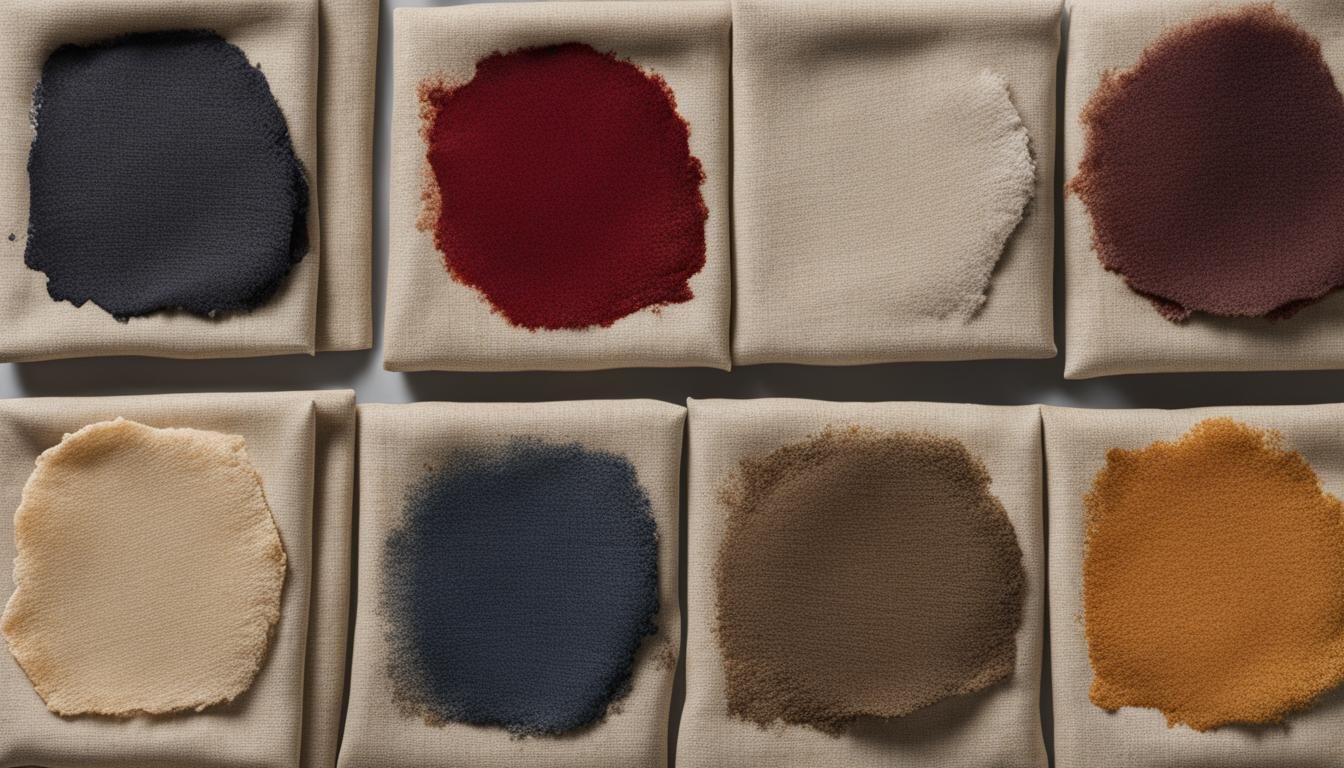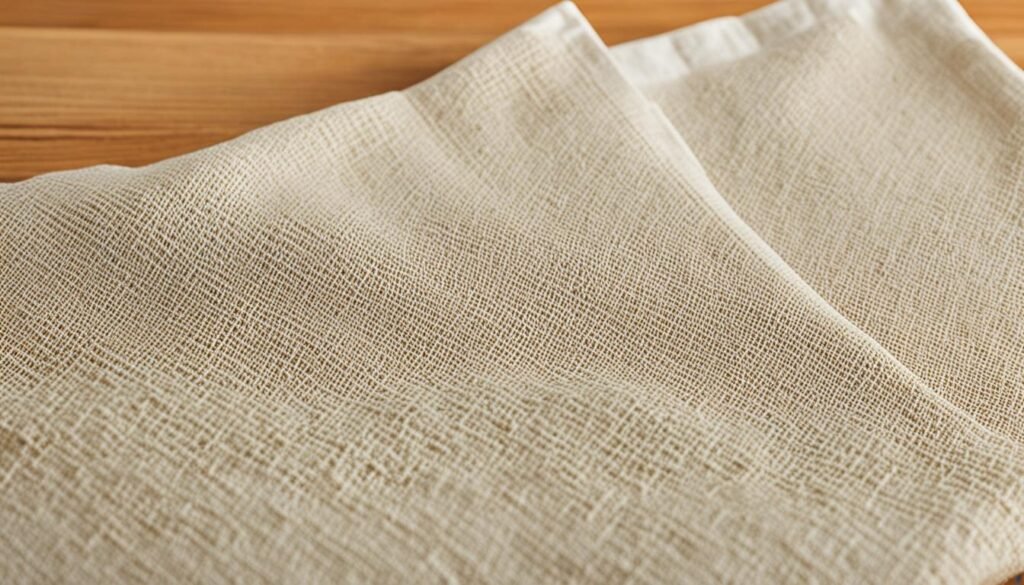Your cart is currently empty!

Effortless Guide to Removing Stains from Linen
Staying ahead of life’s little accidents is crucial, especially when it comes to maintaining spotless linen. Linens bear the brunt of many stains, but with expert stain treatment tips, your cherished fabric can look as good as new. Whether it’s a splash of red wine or a brush with ink, acting swiftly is your first line of defense to ensure fresh linens. A methodical approach to linen stain removal, from pre-treatment to the final wash, allows you to tackle stubborn stains with confidence.
Key Takeaways
- Acting fast on stains can prevent them from becoming a permanent mark on your linen
- Blotting is preferable to rubbing to avoid pushing the stain deeper into the fibers
- Checking care labels is essential for understanding the proper handling and treatment of the fabric
- Using the right water temperature is crucial; cold or lukewarm water is typically recommended for most stains
- For special care fabrics or cherished items, professional dry cleaning may be the best option
Quick Response: The Key to Successful Stain Treatment
Understanding that time is of the essence is fundamentally crucial when preserving the pristine condition of your linens. When confronted with an unexpected blotch or smear, a prompt and decisive response can mean the difference between a simple wash and a stain that lingers indefinitely. Embracing the proper pre-treatment methods for stains, coupled with the gentle finesse of blotting, and adhering to the specifics of linen care instructions, are pivotal steps in effective fabric maintenance.
Pre-treat With Proven Methods
Embarking on the stain removal journey begins with the science of pre-treatment. Whether managing a recent spill or addressing an enduring spot, various approaches stand at the ready. Fresh stains warrant an immediate cold soak, halting their intrusion into the linen’s fibers. Dried stains plead for the enzymatic prowess found within specialized laundry products. It is this pre-emptive effort that lays the groundwork for successful stain removal.
Blot, Don’t Rub: The Technique Matters
The strategy deployed in these crucial moments must be deliberate. In the face of a blemish, to blot is to treat the linen with the respect it deserves. This simple act signifies not only a physical dabbing motion but a commitment to preserve the intricacy of the weave. Rubbing would, in contrast, only serve to further embed the unwelcome pigment, thwarting one’s removal endeavors.
Check Fabric Care Labels: Every Linen’s Needs
The guardians of fabric wisdom lie in the small tags sewn onto the seams. Herein, one’s path is illuminated with linen care instructions that direct the temperature of water, the gentleness of cycles, and the necessity for professional handling. This is a linen’s lexicon, inscribed to ensure the longevity of your cherished textile treasures.
The following Stain Removal Guide offers a user-friendly reference for addressing common linen stains:
| Stain Type | Pre-treatment for Washables | Pre-treatment for Nonwashables |
|---|---|---|
| Fresh Blood | Soak in cold water, then launder | Flush with cold water, apply diluted white vinegar |
| Chocolate | Pretreat with enzyme product, then launder | Apply diluted white vinegar, flush with cool water |
| Oil-Based Paint | Use recommended solvent, then launder | Blot excess and take fabric to dry cleaner |
| Perspiration | Ammonia or white vinegar, then launder with enzyme product | Apply diluted white vinegar, flush with cool water |
| Red Wine | Cover with salt, stretch fabric over bowl, pour boiling water | Apply diluted white vinegar, flush with cool water |
Following the guide above provides a clear pathway for both first-time and seasoned caretakers of linens. With a little knowledge and prompt response, even the most challenging stains can be lifted, rendering your linen articles as immaculate as the day you first brought them into your home.
Removing Stains from Linen: A Handy Guide
When faced with the challenge of cleaning linen fabric, it’s imperative to apply linen stain techniques that are not only effective but also preserve the quality of the fabric. Here’s an insightful guide on the effective linen stain removal for those unwelcome spots that threaten the beauty of your linen items.

For starters, dealing with stains promptly can significantly increase the chances of complete removal. Fresh stains require immediate attention and should be soaked or sponged with the appropriate solution, such as cold water for blood or a diluted white vinegar solution for coffee or tea stains.
Have a look at the comprehensive stain removal chart below to find the perfect solution for washable and non-washable linen items:
| Stain Type | Effective Linen Stain Removal Technique for Washables | Cleaning Linen Fabric Solution for Nonwashables |
|---|---|---|
| Blood | Soak in cold water; treat with enzyme cleaner before laundering | Flush with cold water; follow with diluted white vinegar |
| Grease/Oil | Apply liquid dish soap; launder in hot water if the fabric allows | Require professional dry cleaning |
| Coffee/Tea | Soak in cool water; pretreat with laundry detergent before washing | Apply diluted white vinegar with an eyedropper; rinse with cool water |
| Lipstick | Blot mineral oil onto stain; treat with ammonia-water solution after rinsing | Blot mineral oil and take to professional dry cleaner |
| Red Wine | Cover with salt, pour boiling water over fabric; pretreat and wash | Apply diluted white vinegar with an eyedropper; rinse with cool water |
By following these steps, you can tackle various common stains with great effectiveness. Whether it’s a delicate linen blouse or a sturdy tablecloth, the right approach can restore your linens back to their original elegance.
Remember, different stains may require distinct treatments, so it’s crucial to know the substance causing the stain. A substance like ink or paint will have different removal methods compared to organic stains like wine or blood. Moreover, some stains may need repeated treatment or professional care, particularly if the linen is non-washable or the stain is particularly stubborn.
For instance, ink stains on washable fabrics can be pretreated with stain remover and then laundered. However, for non-washables, creating a solution of glycerin, clear dishwashing detergent, and water with a few drops of white vinegar could be a savior, especially if the stain has had time to set.
Lastly, it’s good to note the importance of natural alternatives. Lemon juice, salt, and baking soda often come in handy for a variety of linen stains and are especially useful for items that can’t withstand harsh chemicals. Not only are they readily available, but they also offer an environmentally friendly solution to your stain troubles.
With this guide and by acting swiftly, you can maintain the aesthetics and longevity of your linen items, ensuring they remain immaculate and in perfect condition for years to come.
Dealing With Common Stains on Linen Fabric
Linen fabric, with its natural elegance and durability, frequently becomes the unintended canvas for common linen stains. The key to preserving the fabric’s beauty is prompt and appropriate treatment methods. From protein-based stains to those stubborn spots that defy normal laundering, understanding how to combat these pesky intruders is essential for any linen enthusiast.
Handling Protein-based Stains Like Blood and Grease
Protein-based stain treatment requires swift action. Washable linen items benefit from an immediate application of a commercial stain remover or laundry detergent, followed by washing in the hottest water recommended on the care label. Nonwashables aren’t without hope; white vinegar has proven to be a resourceful ally. Its mild acidity breaks down protein bonds, allowing stains to rinse away more easily. This method respects the delicate nature of the fabric while effectively diminishing the appearance of unsightly stains.
Natural Solutions for Stubborn Stains
For those who prefer natural stain solutions, an array of homemade stain remedies is at your disposal. A paste made from baking soda and water can lift a variety of stains when applied gently to the affected area. Lemon juice acts as a gentle bleaching agent, ideal for light-colored linens, while vinegar serves multiple purposes, tackling everything from coffee spills to deodorant marks. These ingredients are nature’s answer to maintaining the pristine condition of linen without resorting to harsh chemicals.
Commercial Stain Removers Versus Homemade Mixtures
When deliberating between commercial stain removers and homemade mixtures, weigh the type of stain against the recommendation for the fabric. Some modern formulations boast enzymes specifically designed to break down complex stains, making them particularly effective for specific cases. Yet, these robust solutions aren’t always necessary. More often than not, the gentleness and ecological friendliness of baking soda, vinegar, or lemon juice will suffice, preserving both your linens and the environment.
FAQ
What immediate actions should I take for linen stain removal?
Immediate actions include blotting the stain with a clean cloth, pre-treating with a recommended stain remover, and soaking in cold water if applicable. Avoid rubbing the stain to prevent it from embedding further into the fabric.
Why is it important to check the fabric care label before attempting to remove stains from linen?
The fabric care label contains crucial information about the linen’s washing and drying requirements, including water temperature guidelines and whether the item should be professionally dry cleaned. Tailoring your treatment according to these instructions helps ensure safe and effective stain removal.
Can I use natural solutions to treat stains on linen?
Yes, natural solutions such as baking soda, white vinegar, and lemon juice can be effective for treating various stains on linen. They are eco-friendly and can be gentler on fabrics compared to some commercial stain removers.
How should I handle protein-based stains like blood and grease on linen fabrics?
For machine-washable linens, promptly pre-treat the stain with a stain remover or laundry detergent, and launder in the warmest water safe for the fabric. For non-washable fabrics, treating with a diluted white vinegar solution may help before seeking professional cleaning services.
What are the advantages of using homemade stain removal mixtures on linen?
Homemade stain removal mixtures can be less harsh on the fabric, more cost-effective, and environmentally friendly. They can be customized for different types of stains and serve as an alternative when commercial products are not available or suitable.
How do I treat a red wine stain on linen?
Blot the red wine stain immediately with a dry cloth to absorb as much liquid as possible. Pre-treat with a suitable stain remover and launder following care label instructions. Avoid using hot water as it can set the stain.
What is the suggested method for removing oil-based paint from linen?
For oil-based paint, initially, remove the excess paint carefully. Then use the paint thinner recommended on the paint label or try turpentine, applied sparingly. If the fabric is machine-washable, launder it per the care label after treatment.
Is it safe to use bleach on linen fabric for stain treatment?
Only use bleach if it is labeled safe for use on your particular linen garment. Always dilute according to instructions and test on an inconspicuous area first. Some linens are not bleach-resistant and could be damaged by harsh chemicals.
Can I place stained linen in the dryer?
Do not place the linen in the dryer until you are certain the stain has been completely removed. Heat from the dryer can permanently set the stain into the fabric making it much more difficult to remove later.
How can I remove ink stains from my linen items?
Blot excess ink with a clean cloth, apply a small amount of rubbing alcohol or nail polish remover on the area, and gently blot. Rinse with cold water and treat with a prewash stain remover before laundering as per care label instructions.
Leave a Reply